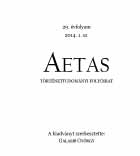Kódex – szöveg – szöveghagyomány: Problémák és vitás kérdések a keleti szláv krónikák kutatásában
Codex–Text–Textual Tradition. Problems and Controversial Questions in the Study of East Slavic Chronicles
Author(s): Márta FontSubject(s): History
Published by: AETAS Könyv- és Lapkiadó Egyesület
Summary/Abstract: As they precede the legal and official “production of documents”, narrative sources play an important role in the reconstruction of the Early Middle Ages – this was typical in the East Slavic territories until the end of the 13th century. That stories about the past were the first to be recorded is partly attributable to the fact that historiography was a means of legitimation for the dynasties in power. Stories about the past also had a message for the present, basically they were a means of propaganda. Dating the pieces of information related in narrative sources – including historiography – and their authenticity are key questions for research. However, the answers are never simple, they are often hypothetical. East Slavic historiography has a couple of peculiarities. First, the language, which is difficult to definite as East Slavic peoples and languages in the middle ages had structures different from what we see today, and also several versions of the written language were in use. Even the very name of the language is subject to debate to this day. Second, Slavic chronicle literature was linked to the Greek Orthodox branch of the Christian world, this is where it borrowed the genres, the style and the chronology from. The numbering of years from the “foundation of the earth” combined with the fact that for Slavic people the year started in March, whereas according to the Byzantine calendar in September, led to dating issues. In the East Slavic territory, historiography followed the territorial changes of the principalities: after the works providing a comprehensive view of the Kievan Rus' a more regional point of view started to dominate. From the 15th century, the dominant view of history became that of the court of the Moscow princes and the ecclesiastical center of Moscow. This is where most of the manuscripts have survived, and these in retrospect described Moscow, as well as those considered its historical predecessors, as having more influence that it actually had. Medieval historiography and the then emerging study of history coexisted in the second half of the 17th century. Opinions about the works of the author (Tatishchev), who was standing on the borderline between the two approaches, vary widely. The paper presents the current views, controversies and directions in the study of the above-mentioned questions, together with the author's critical comments.
Journal: AETAS - Történettudományi folyóirat
- Issue Year: 2014
- Issue No: 1
- Page Range: 25-40
- Page Count: 16
- Language: Hungarian

